February 7-11, 2017
After camping off Darby Well Road for several days I went exploring Organ Pipe Cactus National Monument about 30 miles south. This national monument is listed as a showcase for the lush and diverse Sonoran Desert with its extreme temperatures and limited rainfall where all species must adapt to survive.
 Only a few miles past Why there is a Border Patrol inspection station but southbound traffic wasn’t being stopped. I’m sure with the multiple speed bumps a camera has time to take a photo of your license plate and there’s not too many places to easily run away. Guess I passed inspection as I didn’t get arrested over the four days in the monument and saw plenty of border patrol vehicles while driving the back roads.
Only a few miles past Why there is a Border Patrol inspection station but southbound traffic wasn’t being stopped. I’m sure with the multiple speed bumps a camera has time to take a photo of your license plate and there’s not too many places to easily run away. Guess I passed inspection as I didn’t get arrested over the four days in the monument and saw plenty of border patrol vehicles while driving the back roads.
 Tuesday was my first day in the park and I paid for two nights at Twin Peaks Campground which even though large with first-come first-served can fill up during the winter months. Most sites are pull-through with the last few rows set aside for no generators and tent camping where I parked. And with my Senior Pass providing half off it was like getting two nights for the price of one.
Tuesday was my first day in the park and I paid for two nights at Twin Peaks Campground which even though large with first-come first-served can fill up during the winter months. Most sites are pull-through with the last few rows set aside for no generators and tent camping where I parked. And with my Senior Pass providing half off it was like getting two nights for the price of one.
 Second stop, the visitor center where I found my friend Cynthia, picked up all the park literature, and attended a Ranger program where I ran into Michael, Imkelina, and their dog Sydney. Of course I picked up Junior and Not so Junior Ranger books. I love the idea of an adult version and would love to see us do this at Grand Canyon. Back to camp for lunch and a cold solar shower which was brief but still felt good.
Second stop, the visitor center where I found my friend Cynthia, picked up all the park literature, and attended a Ranger program where I ran into Michael, Imkelina, and their dog Sydney. Of course I picked up Junior and Not so Junior Ranger books. I love the idea of an adult version and would love to see us do this at Grand Canyon. Back to camp for lunch and a cold solar shower which was brief but still felt good.
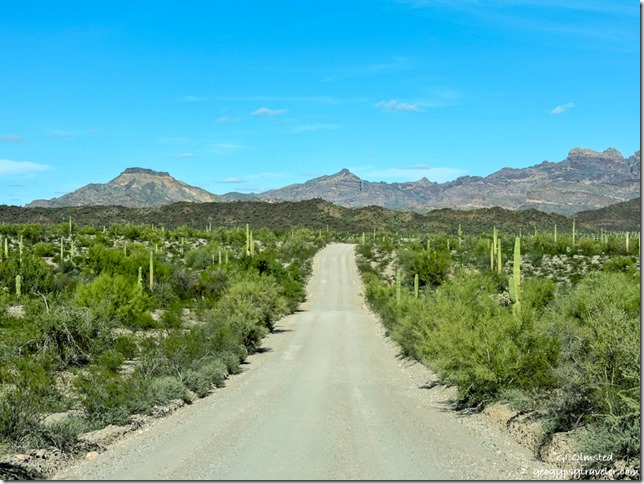 Then I took off to drive the 21-mile slightly rough gravel Ajo Mountain Drive, a fantastic loop up, over, and around the Diablo Mountains. Ask for the guide at the visitor center, which I had with me but forgot to use that day. And get an earlier start than my 3:30pm because it’s not only a slow drive but you’ll want to make many stops along the way.
Then I took off to drive the 21-mile slightly rough gravel Ajo Mountain Drive, a fantastic loop up, over, and around the Diablo Mountains. Ask for the guide at the visitor center, which I had with me but forgot to use that day. And get an earlier start than my 3:30pm because it’s not only a slow drive but you’ll want to make many stops along the way.
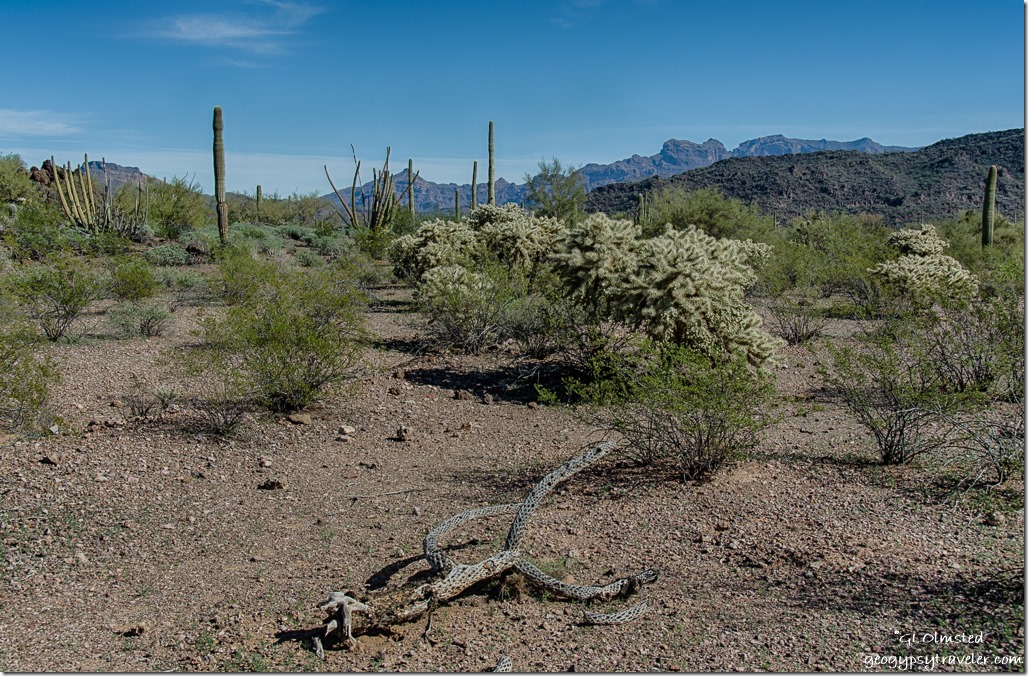 The Sonoran Desert stretches for 120,000 square miles through Arizona, California, and into the Mexican states of Sonora and Baja California. It is the only place in the world where the saguaro (sa-WA-roh) cactus grows naturally. As the largest cactus in the US, the saguaro grows very slowly, up to 50 feet tall in about 125 years. Palo verde trees often serve as “nurse” trees for saguaro seedlings providing shelter until they are established. As the cactus matures it competes with the tree for moisture. Palo verde have deep roots to seek the water table while saguaro have shallow spreading roots to gather the water from rains. The saguaro in turn provides food and shelter for many species of birds, mammals, and insects with payback when insects and bats pollinate its flowers, and other wildlife eat its fruit and disperse its seeds. Everything works together to maintain this intricate, well balanced community.
The Sonoran Desert stretches for 120,000 square miles through Arizona, California, and into the Mexican states of Sonora and Baja California. It is the only place in the world where the saguaro (sa-WA-roh) cactus grows naturally. As the largest cactus in the US, the saguaro grows very slowly, up to 50 feet tall in about 125 years. Palo verde trees often serve as “nurse” trees for saguaro seedlings providing shelter until they are established. As the cactus matures it competes with the tree for moisture. Palo verde have deep roots to seek the water table while saguaro have shallow spreading roots to gather the water from rains. The saguaro in turn provides food and shelter for many species of birds, mammals, and insects with payback when insects and bats pollinate its flowers, and other wildlife eat its fruit and disperse its seeds. Everything works together to maintain this intricate, well balanced community.
 A seasonal pattern of light winter rains and heavy summer thunderstorms make the Sonoran Desert lush compared to other deserts. Creosote bushes grow everywhere interspersed with prickly pear cactus and thorny mesquite trees. Multiple species of cholla (CHOY-yuh) hung heavy with buds. The fountain-like stalks of the ocotillo (OH-koh-TEE-yo) were covered in rows of tiny dark green leaves and a few burst at the tips with brilliant red flowers. Despite the long sharp thorns this is not a cactus but a shrub that drops all leaves during dry times and resembles a bundle of sticks.
A seasonal pattern of light winter rains and heavy summer thunderstorms make the Sonoran Desert lush compared to other deserts. Creosote bushes grow everywhere interspersed with prickly pear cactus and thorny mesquite trees. Multiple species of cholla (CHOY-yuh) hung heavy with buds. The fountain-like stalks of the ocotillo (OH-koh-TEE-yo) were covered in rows of tiny dark green leaves and a few burst at the tips with brilliant red flowers. Despite the long sharp thorns this is not a cactus but a shrub that drops all leaves during dry times and resembles a bundle of sticks.
 And of course the name sake organ pipe cactus named by early settlers thinking the dead cacti looked like church pipe organs. And here I thought it was because the organ pipe is said to hum in the wind. Because severe frosts can kill this cactus it typically grows on southern slopes where it can absorb the most sun and its range doesn’t go much further north than the national monument.
And of course the name sake organ pipe cactus named by early settlers thinking the dead cacti looked like church pipe organs. And here I thought it was because the organ pipe is said to hum in the wind. Because severe frosts can kill this cactus it typically grows on southern slopes where it can absorb the most sun and its range doesn’t go much further north than the national monument.
Because of recent rain the whole desert looked extremely lush in many shades of green. At my many stops along the drive I wandered a sinuous/snakey path on rocky soil using extreme caution not to bump into any of this prickly growth.
 Then I’d drive a little closer towards the Diablo Mountains. This landscape is made up of steep, blocky mountain ranges that alternate with the flat, narrow valleys, part of the Basin and Range that covers much of the Southwest. The surrounding mountains were created by the eruptions of ancient volcanoes. Hot ash blown from these volcanoes fell in layers and as the ash cooled it solidified into rock called ash-fall
Then I’d drive a little closer towards the Diablo Mountains. This landscape is made up of steep, blocky mountain ranges that alternate with the flat, narrow valleys, part of the Basin and Range that covers much of the Southwest. The surrounding mountains were created by the eruptions of ancient volcanoes. Hot ash blown from these volcanoes fell in layers and as the ash cooled it solidified into rock called ash-fall tuff. This is topped by rhyolite flows which would have moved slowly across the land scraping up fragments of other rocks and cementing them together to form a new rock called breccia.
tuff. This is topped by rhyolite flows which would have moved slowly across the land scraping up fragments of other rocks and cementing them together to form a new rock called breccia.
I came around a curve and couldn’t believe my luck with the waxing moon hanging over a saddle to the left of an arch. There is a .6 mile trail into Arch Canyon but it was getting late in the afternoon so I just enjoyed the view feeling fortunate to have caught this moment.
 I gave a look back as I continued down the road and couldn’t believe my luck seeing the moon through the arch, a serendipitous moment. Do you see it’s a double arch? I didn’t see any wildlife except a few birds probably because it was the middle, and hottest, part of the day.
I gave a look back as I continued down the road and couldn’t believe my luck seeing the moon through the arch, a serendipitous moment. Do you see it’s a double arch? I didn’t see any wildlife except a few birds probably because it was the middle, and hottest, part of the day.
 I returned to camp just before sunset thinking I’d attend the Ranger’s evening program with Cynthia but I was just too tired from the long day and really wanted to see the photos I’d taken of this indescribable desert landscape. I’m really trying, or it’s really tying, to use the tripod more frequently. I’ve noticed that my hand-held shots are often not sharp. But that dang tripod is heavier than the camera.
I returned to camp just before sunset thinking I’d attend the Ranger’s evening program with Cynthia but I was just too tired from the long day and really wanted to see the photos I’d taken of this indescribable desert landscape. I’m really trying, or it’s really tying, to use the tripod more frequently. I’ve noticed that my hand-held shots are often not sharp. But that dang tripod is heavier than the camera.
 Wednesday I headed for the 14 mile South Puerto Blanco Drive that winds through the Sonoyta Mountains to the La Abra Plain which parallels the US and Mexican border. Signs warn of smugglers telling you not to stop or leave your vehicle unattended. I saw several border patrol vehicles along this rough road while within sight in Mexico is a nicely paved road. I became distracted and obsessed with the wall—which is mostly just a fence—to the point I couldn’t appreciate the beauty of the desert. Does the land know it belongs to different people?
Wednesday I headed for the 14 mile South Puerto Blanco Drive that winds through the Sonoyta Mountains to the La Abra Plain which parallels the US and Mexican border. Signs warn of smugglers telling you not to stop or leave your vehicle unattended. I saw several border patrol vehicles along this rough road while within sight in Mexico is a nicely paved road. I became distracted and obsessed with the wall—which is mostly just a fence—to the point I couldn’t appreciate the beauty of the desert. Does the land know it belongs to different people?
 All I could think about was Pink Floyd. I could have parked, walked under the fence, and gone for lunch at a café within sight. Of course I’d have taken my passport with me. After about five miles with the road getting progressively worse I turned around.
All I could think about was Pink Floyd. I could have parked, walked under the fence, and gone for lunch at a café within sight. Of course I’d have taken my passport with me. After about five miles with the road getting progressively worse I turned around.
 After returning to pavement I drove the mile south to Lukeville at the border crossing. I had no intention of crossing but just had to look. Not much there but did top off with fuel. Good thing because another person at the pump said no diesel in Why that day.
After returning to pavement I drove the mile south to Lukeville at the border crossing. I had no intention of crossing but just had to look. Not much there but did top off with fuel. Good thing because another person at the pump said no diesel in Why that day.
 I paid for two more nights at the campground then wandered in my current back yard. My site on the outside loop offered nothing but desert beyond. The moon seemed to look down on the land. And as the sun sank the desert life took on a golden glow.
I paid for two more nights at the campground then wandered in my current back yard. My site on the outside loop offered nothing but desert beyond. The moon seemed to look down on the land. And as the sun sank the desert life took on a golden glow.
 After sunset I went to the evening program about the brilliance of planets we can see with the naked eye. Venus was visible but the sky was dominated by the almost full moon.
After sunset I went to the evening program about the brilliance of planets we can see with the naked eye. Venus was visible but the sky was dominated by the almost full moon.
 Thursday I returned to the Ajo Mountain Drive with another late morning start even though I was up for sunrise.
Thursday I returned to the Ajo Mountain Drive with another late morning start even though I was up for sunrise.
 This time I used the guide stopping at all the numbered points along the way. And, this time I saw crested, or cristate, cactus. First a saguaro and then an Organ Pipe Cactus. According to the guide cactus have growth cells on the tips of their arms that grow in a circle. But some growth cells form a straight line that creates the crest. There are several scientific hypothesis but this beautiful phenomenon is still unexplained.
This time I used the guide stopping at all the numbered points along the way. And, this time I saw crested, or cristate, cactus. First a saguaro and then an Organ Pipe Cactus. According to the guide cactus have growth cells on the tips of their arms that grow in a circle. But some growth cells form a straight line that creates the crest. There are several scientific hypothesis but this beautiful phenomenon is still unexplained.
The suggested time for the entire loop drive is two hours. At 3 1/2 hours I was only about half way. I often drive no more than 5mph because 15mph seems too fast to whiz past the landscape. Traffic was no problem with only a few cars passing me when I used pullovers. Most drivers weren’t going a whole lot faster than me anyway.
 Friday I again started a late morning drive this time on the North Puerto Blanco Drive about five miles to the turn around where the road becomes one way for another 16 miles and requires high clearance and perhaps 4×4 to loop back to the South Puerto Blanco Drive.
Friday I again started a late morning drive this time on the North Puerto Blanco Drive about five miles to the turn around where the road becomes one way for another 16 miles and requires high clearance and perhaps 4×4 to loop back to the South Puerto Blanco Drive.
 It was beautiful, but again I wanted to return to the Ajo Mountain Drive so this time only drove the first 2 1/2 miles to the turn around for that one way loop. Several trails lead from this point but at 104°F I passed on hiking.
It was beautiful, but again I wanted to return to the Ajo Mountain Drive so this time only drove the first 2 1/2 miles to the turn around for that one way loop. Several trails lead from this point but at 104°F I passed on hiking.
 I returned to the visitor center to get my Junior Ranger badge the last day of my stay.
I returned to the visitor center to get my Junior Ranger badge the last day of my stay.
Then instead of shooting the full moon I went to Ajo with Cynthia to a gallery showing where one of her most awesome art quilt wall hangings was on display. And by the way she deservedly won best of show for Art Under the Arches.
I bought myself an early birthday present from the store attached to the show. Just couldn’t help myself with a petti-point turquoise cuff, old pawn, for only $125, a steal of a deal. Then we went to dinner with some fellow Rangers to the advertised “Best Burger and Craft Brew” at Estrellas.
I was beginning to feel like a local even knowing Rangers by name. I asked Cynthia who I could volunteer for just to drive the Ajo Mountain Road daily. Still more to explore, roads, trails, Ranger programs, and maybe flowers coming. I just might have to return to Organ Pipe Cactus National Monument, soon.
So I may have missed the full moon rise yet figured to get another chance Saturday night. But as this post is already too long that’s another story.



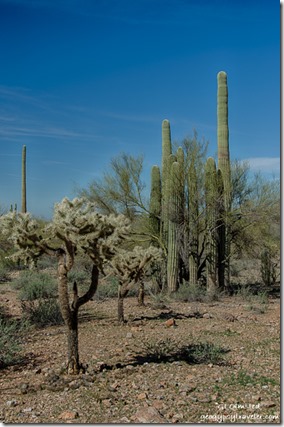

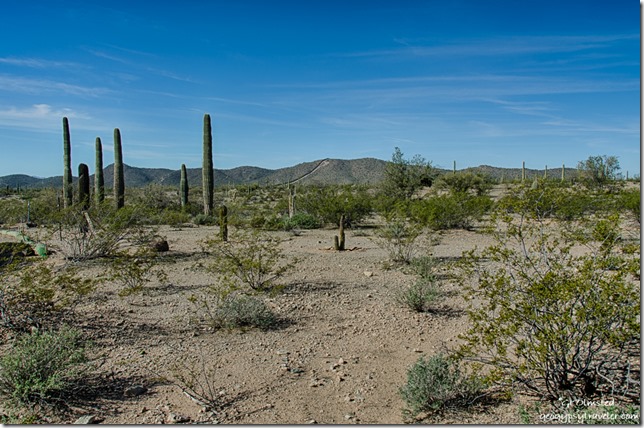
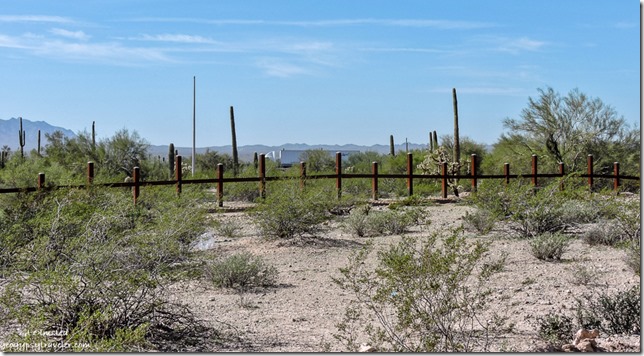






This is such a wonderful area. We loved Organ Pipe NM and did three different hikes. We hiked two days and 15 miles in search of the Senita Cactus. This is one of the only places it grows in the wild. Thank goodness for John we ran into Border Patrol and one friendly Park Ranger on our second day who directed us to them. There were also several gorgeous crested saguaro along the road from Why to Organ Pipe. Your photos are beautiful!! Glad you enjoyed your visit:)
I saw a few crested saguaros when Cynthia pointed them out on the fly to Ajo from the park. I, unlike you, am not a crest whisperer. 😉 I never see any Senita, other than behind the VC. Ah, an excuse to return and ask where they are. Plus the temps have cooled down a bit so I could hike.
We loved Organ Pipe as well. We were there last October. No one in the campground to speak of at that time and the solar heated shower was hot!
The crested cacti are quite interesting. We missed the saguaro, even though we looked for it.
I’m ready to go back and not far away. But think I’d rather pay for a guaranteed Hot shower. The campground wasn’t full, but very busy. Saw another crested organ pipe cactus today.
I love that they have special areas for no generators. I think all campgrounds should. If you want to run one then you can be with everyone else running one too. Your site looks great!
I am so happy to hear that at least some parks have “not so junior Ranger” programs. I think lots of adults have a lot to learn about the natural world and some are eager to do so. Count me in!
Love your description of the interdependence of the Suguaro and its surroundings. And so it is in all of nature. So intelligent.
Thanks so much for all of the pronunciation guides. I admit to not having spent nearly enough time in the desert SW and being unsure of how to say things. Impossible to say which of your just beautiful desert landscape pictures here I like the best. But the moon through the arch is just magnificent. Lucky you to have been there at just the right moment. Makes me wonder if it didn’t set itself up when a good photographer came along. These are coffee table book pictures. What great cresteds you saw.
Your cuff is gorgeous! Sorry I had such blabberfingers. Couldn’t help myself. Loved this post and hope hope to someday see all this in person right from that same campground. Your posts from the west make me yearn.
As with the Junior Ranger program, it takes have good partners and history associations to pay the printing costs, plus badges, and sometimes patches. All it takes is money. BTW, the pronunciations were in my book. The arch with moon was pure luck. Sure glad I was there. Thank you. I love your “blabberfinger” comments. Sure hope you get back west soon.
Wonderful photos as always. The desert is a magical place. My son is a Border Patrol agent and I know he would tell me not to go there.
Rosemary
Thanks Rosemary. It is magic here but I will stay away from the border.
You had quite the adventure and certainly got some good moon shots. I do okay with the moon up close but have failed to get a moon shot in context with land features.
I have just the opposite problem shooting the moon even with a tripod. We need to share tricks of the pics.
Wonderful narrative, Gaelyn. Nancy and I have camped a number of times in Organ Pipe. One time we specifically went there to have a nice dark sky so I could photograph Comet Hale-Bopp. Your photos of the Waxing Moon are beautiful. The bracelet you bought is indeed a beauty and as you indicated, quite a deal.
Thank you George. I’m loving this part of the desert and return to the park tomorrow. Would be an awesome place for dark sky photography. Which I need a lot of practice with.
Loved this post — thanks for the memories. Even though I was thinking about Why from your later post (which I read first), at first I still read your paragraph above as “Why is there a border station”. (Hmm … I will not make any further comment on the state of my brain.) Anyway, I am loving catching up with your posts and as soon as I finish doing that I am off to read my travel diary to find out where we stayed in Why and Ajo (too long ago, I do know that).
Thank you. I love to stir memories and hope you’ll let me know where you stayed in Why and Ajo.